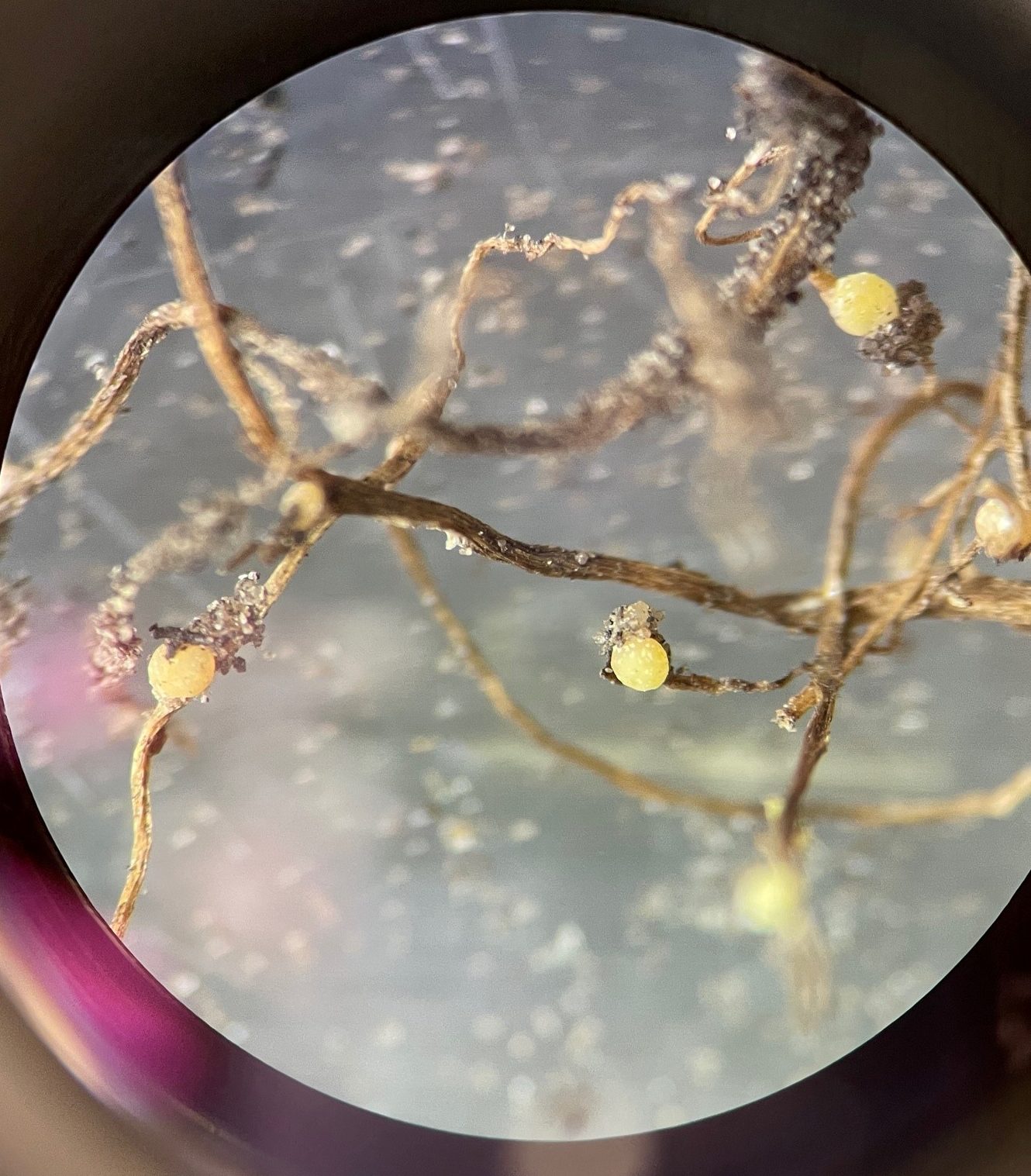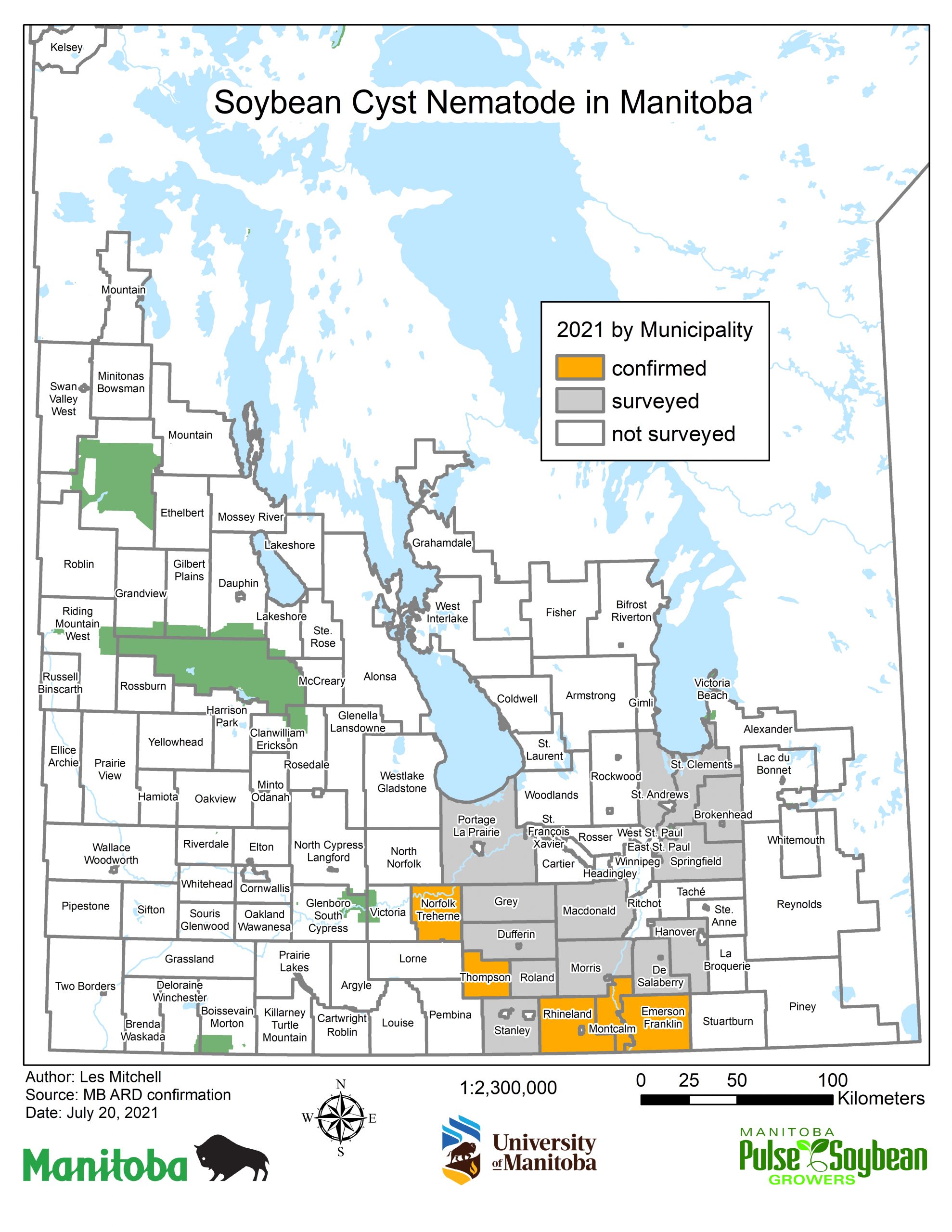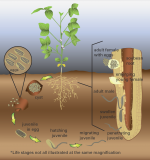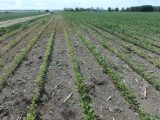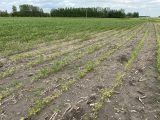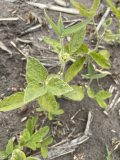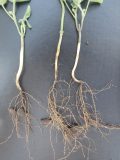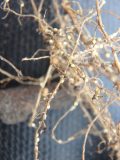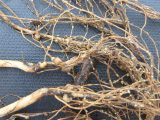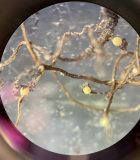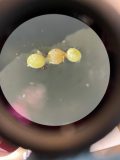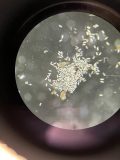About SCN
Soybean cyst nematode (SCN) is a microscopic roundworm that parasitizes soybean roots. Different types of nematodes can commonly be found in Manitoba, but not all are harmful to crops. SCN is a harmful type of nematode and one of the most damaging pests to soybean crops in North America. Preventative action, early detection and timely management are key in avoiding significant yield loss from SCN.
Infection of SCN can impact growth and yield by removing plant nutrients, disrupting nutrient and water uptake and impeding root growth. It can also reduce the number of root nodules and therefore inhibit nitrogen fixation. SCN-infected plants may also be more susceptible to the development of root rot and seedling diseases, due to openings in the root created by cysts. Once above-ground symptoms are noticed, up to 30% yield loss can already be expected.
Status in Manitoba
The presence of SCN was confirmed for the first time in Manitoba in 2019. This confirmation was made possible due to survey efforts led by Dr. Mario Tenuta and his laboratory (University of Manitoba) that have taken place from 2012 to 2019. SCN was identified by visual and molecular DNA methods in four out of 106 fields and four out of 18 municipalities sampled across all surveys. In July of 2021, another case of SCN was confirmed. The arrival and spread of SCN in Manitoba is not surprising given the northward movement and distribution throughout North America.
This makes a total of five rural municipalities with a confirmed presence of SCN (one field within each R.M.), including Thompson, Norfolk-Treherne, Rhineland, Emerson-Franklin and Montcalm. Given the large gap between regions with positive identification, it is possible that SCN may be present in fields not included in the survey. It is also possible that SCN may have established itself in surveyed fields since the sampling has taken place.
Cyst populations found within the four fields identified in 2019 are extremely low and consistent with recent establishment of this pest (1-14 cysts/5 lbs of soil across the four locations). However, in the most recently identified case, the SCN population was greater than previous discoveries, at 32 cysts or 1350 eggs/100 mL soil. As a point of reference, a field infested with 10,000 SCN eggs/100 cc of soil could experience 50% or more yield loss. Note: 100 mL is the same as 100 cc or 100 g.
More on the 2021 Discovery
An area with poor soybean growth and above-ground yellowing along a field edge was investigated by a local agronomist who found several tiny, lemon-shaped cysts on the roots. Dr. Mario Tenuta’s lab at the University of Manitoba later confirmed by polymerase chain reaction (PCR) test that it is SCN.
In the case of this field, symptoms were also found at a relatively higher point of elevation within the field, suggesting it is not exclusive to low spots. Cysts were also found on nearby plants that appeared completely healthy above-ground. SCN is also most easily detected during dry years and in lighter soils (a characteristic of this field).
Prevention and Management
Once SCN has arrived, it cannot be completely eradicated and can spread rapidly. Anything that moves soil can contribute to the spread of SCN. Since the pest has only recently established itself in the province, cleaning the soil off of equipment, vehicles, soil sampling equipment and clothing will reduce the risk of introduction or spread.
Eggs can survive for several years in the absence of a soybean crop. However, SCN requires a host plant to reproduce. Management options to minimize the population of SCN include rotating to non-host crops, growing SCN-resistant varieties, reducing tillage and controlling host weed species.
Scouting and Identification
Scout for SCN from late July through September, during the reproductive stages until maturity, by gently digging up roots and examining them for cysts. Roots should be soaked in water to avoid breaking off any potential cysts. Late-season scouting should be done prior to any tillage operations. Assess the most high-risk areas of a field, including:
- Any generally low-yielding areas
- Approaches and field edges
- Low spots
- Shelter belts
- High pH areas
Above-Ground Symptoms
Unfortunately there are no distinct, above-ground symptoms specific to SCN. So it is possible that we may already be seeing it in other fields, but have not identified it. At low levels of infection, plants may still appear healthy. At high levels of infection, plants may appear stunted and chlorotic or necrotic. Symptoms may resemble nutrient deficiencies, drought stress or other abiotic factors. Therefore, digging up the roots is the best way to identify this pest.
Below-Ground Symptoms
Below-ground symptoms are more unique due to the presence of white, lemon-shaped cysts on the roots. These cysts are much smaller than root nodules and may require the use of a magnifying lens. When scouting, it is recommended to carefully dig out the entire root system and soak in water to remove the soil without breaking off any cysts.
If you suspect SCN in your field, contact Manitoba Pulse & Soybean Growers or Manitoba Agriculture and Resource Development.
Soil Testing for SCN
If SCN is suspected, soil samples can be collected and submitted to Agvise following the correct soil sampling protocol:
- Target soil collection from suspect areas.
- Sample after harvest and prior to soil freeze-up. If sampling after soybean harvest, sample directly within harvested rows prior to tillage. Following other crop harvest, sample after fall tillage if this is your common practice.
- Collect 15 cores from every 20 acres. Sample the top 8 inches using a push probe or small diameter soil auger.
- Mix soil cores in a pail and place in a zip-lock bag. Label, refrigerate and submit to Agvise as you would with other samples.
- If results come back positive, contact Dr. Mario Tenuta (Soil Ecology Lab UManitoba).
Survey Details
- Cysts were recovered from 12/30 fields in 2017. Most of these cysts were broken and not filled with eggs, preventing accurate identification. Intact cysts were recovered from 7/12 fields. Only 4/7 fields had cysts in good enough condition for molecular testing.
- Molecular DNA analysis of eggs in cysts was conducted using multiple methods. This included two diagnostic polymerase chain reaction (PCR) tests and sequencing of multiple DNA gene targets.
- Cyst populations from the four fields were extremely low and consistent with recent establishment of the nematode. Populations were 2, 1, 14, and 14 cysts per 5 lbs soil in each of the fields. This is compared to 3,000-4,000 cysts per 5 lbs soil in areas of Ontario and the U.S. Midwest, where the nematode has been present for many decades.
- The four fields with positive cyst identification were revisited and sampled again in May 2019. These four fields again had cysts similar to soybean cyst nematode in appearance. Two of the four fields had cysts in good enough shape to examine their molecular DNA, which matched the DNA of soybean cyst nematode.
- One field with a relatively higher cyst population was revisited and sampled again in August 2019. Roots were randomly examined for cysts and some plants had a few white to yellow lemon-shaped cyst nematodes on their roots. There were no visible above-ground symptoms (e.g., stunting, poor canopy closure, chlorosis).
This research is conducted by Ph.D. student Nazanin Ghavami at the University of Manitoba and is a collaborative effort between the University, Manitoba Pulse & Soybean Growers and Manitoba Agriculture. Funding was provided by Manitoba Pulse and Soybean Growers, Manitoba Agriculture and the Western Grains Research Foundation. Albert Tenuta of the Ontario Ministry of Agriculture, Food and Rural Affairs is a project collaborator.
Additional Resources
Soybean Cyst Nematode – Presentation by Dr. Mario Tenuta, University of Manitoba, at MPSG’s 2019 Getting It Right Crop Production Meeting
Manitoba Agriculture Bulletin and Soybean Cyst Nematode Survey Background – Manitoba Agriculture and Dr. Mario Tenuta
Soybean Cyst Nematode – North Dakota State University Extension Service Plant Disease Management Publication
SCN Management Guide Fifth Edition – North Central Soybean Research Program (NCSRP) Publication
Soybean Cyst Nematode (SCN) – University of Minnesota Extension Web Page
Soybean Cyst Nematode of Soybean – Crop Protection Network Web Page
Evaluation of Nematicides for Soybean Cyst Nematode Management – Research Report by Dr. Albert Tenuta, Ontario Ministry of Agriculture, Food and Rural Affairs

